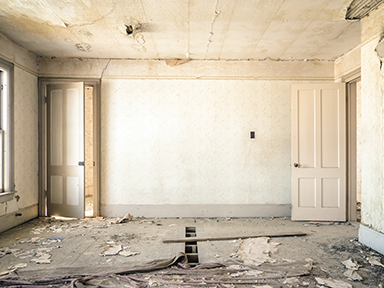If your rental property is vandalised by someone who isn’t your tenant, here’s what you need to do.
It can be devastating to discover that someone has intentionally damaged your rental. No doubt you’ve poured money and attention into your investment, and someone has decided to wreak havoc and damage what you’ve built. You’ll want to get the damage repaired quickly, so it pays to know what to do if you’ve fallen victim and need to make a claim on your landlord insurance.
Vandalism explained
Vandalism is known as the deliberate act of defacing, damaging or destroying property, without the owner’s consent. It includes things like graffiti, arson, deliberately smashing windows, deliberately breaking locks, kicking or punching holes in doors and walls, destroying or knocking down fences, and numerous unsavoury and unhygienic acts at the premises.
Vandalism at rentals
When it comes to damage at a property, the underlying principle is that the person responsible for causing the damage is also legally responsible for fixing it.
Vandalism at a rental can be perpetrated by the tenant (including their children or guests) or by a third-party (e.g. a stranger). In this article, we are going to look at third-party vandalism.
When a rental is damaged by third-party vandalism, the cost of repair or replacement is usually covered under insurance. Depending on the type of damage, property and policy you have, it could be covered through either your landlord insurance or building insurance (or a combination of both). When it comes to landlord insurance, refer to the ‘insured events (malicious acts)’ section of a policy to find out what is and isn’t covered.
What do you need to do if your rental has been vandalised?
Here are six steps for you (or your property manager acting on your behalf) to follow:
Step one: Inform the police
Any vandalism needs to be reported to the police. You’ll need to carry out a preliminary assessment of the damage to give the police, but only enter the premises if it is safe to do so, and only if you are legally allowed (check your jurisdiction’s residential tenancy legislation for details). Heads up! You will need a police report if you want to make a claim on your insurance.
Step two: Inspect the property
Once you’ve reported the vandalism, and assuming it is safe and you are permitted to enter, you should carry out a detailed inspection of the property. If there are tenants in residence you should arrange the inspection with them if possible. Depending on the nature of the vandalism, inspecting the property may be considered an emergency and, subject to state/territory tenancy legislation, you may not need tenant permission to enter the premises. During the inspection, document all the damage. Take plenty of photos and video and be sure to save the files.
Step three: Act to prevent further loss
It is a condition of insurance that the policyholder (or their representative) must take reasonable action to prevent further loss. In the case of vandalism, this may include, for example, boarding up broken windows, arranging for locks or external doors to be replaced or having safety fencing installed around a damaged structure.
You should arrange any emergency repairs that are needed to make the premises and your tenants safe. NOTE: EBM RentCover policyholders do not need to seek prior approval to arrange emergency repairs, but you need to keep all tax invoices for the repairs to submit as part of your claim.
If the premises are uninhabitable, your tenants may need to temporarily relocate. In most cases, you are not financially liable for the costs associated with the temporary relocation. If you do offer to pay, it is important to be aware that your landlord insurance is unlikely to reimburse this cost. As the premises is uninhabitable (in these circumstances), your tenants usually will not be required to pay rent for any time they are not able to reside at the property. Depending on your insurance policy, you may be able to claim the loss of rent.
Step four: Notify your insurer
As soon as possible, you should notify your insurance provider about the vandalism at the property. Your insurer can guide you through what you need to do and how to make an insurance claim.
Step five: Arrange repairs
Be sure to follow any instructions your insurer gives you about quotes for, and arranging, repairs. The insurer may arrange for a loss adjuster to attend the property to ascertain the cause and extent of the damage. All non-emergency repairs typically need to be approved by the insurer prior to the reinstatement being made (so don’t authorise any repairs or buy any replacement items until you are given the go-ahead). If you are covered by an EBM RentCover policy, our Claims Specialists will provide guidance.
Step six: Submit your claim
Once the repairs have been made and your tenants are back in residence (if they needed to temporarily vacate), you can submit your insurance claim. Depending on the damage that was caused, your claim may be for repairs and replacement costs, and also loss of rent. Be sure to submit all the documentation required, including evidence to support your claim (including photos and video, and the police report) and receipts for any repairs, replacements or services to reinstate the property. Your claim will then be assessed and settled.
A question of responsibility
Now you may be wondering about the responsibility aspect. As part of the insurance claims process, a loss adjuster will often be assigned to investigate the loss. Part of their assessment is likely to include a determination as to the cause of the loss.
Legally, the insurer has the right to pursue the person responsible for the loss for the cost of the damage. If the perpetrator of the vandalism is identified and located, the insurer could seek compensation from them.
Our Expert Care team is on hand to help if your rental property has been vandalised. Call us on 1800 661 662 during office hours or call 1300 585 870 if it’s an after-hours emergency (our emergency team is on hand 24/7).
*While we have taken care to ensure the information above is true and correct at the time of publication, changes in circumstances and legislation after the displayed date may impact the accuracy of this article. If you need us we are here, contact 1800 661 662 if you have any questions.
You may also like
View all
When money is tight, eventually something might have to give. And for tenants, that something may just be the rent payment...

Want some safety tips at rentals? Read this...

Damage is damage, right? Well, not when it comes to insurance...



